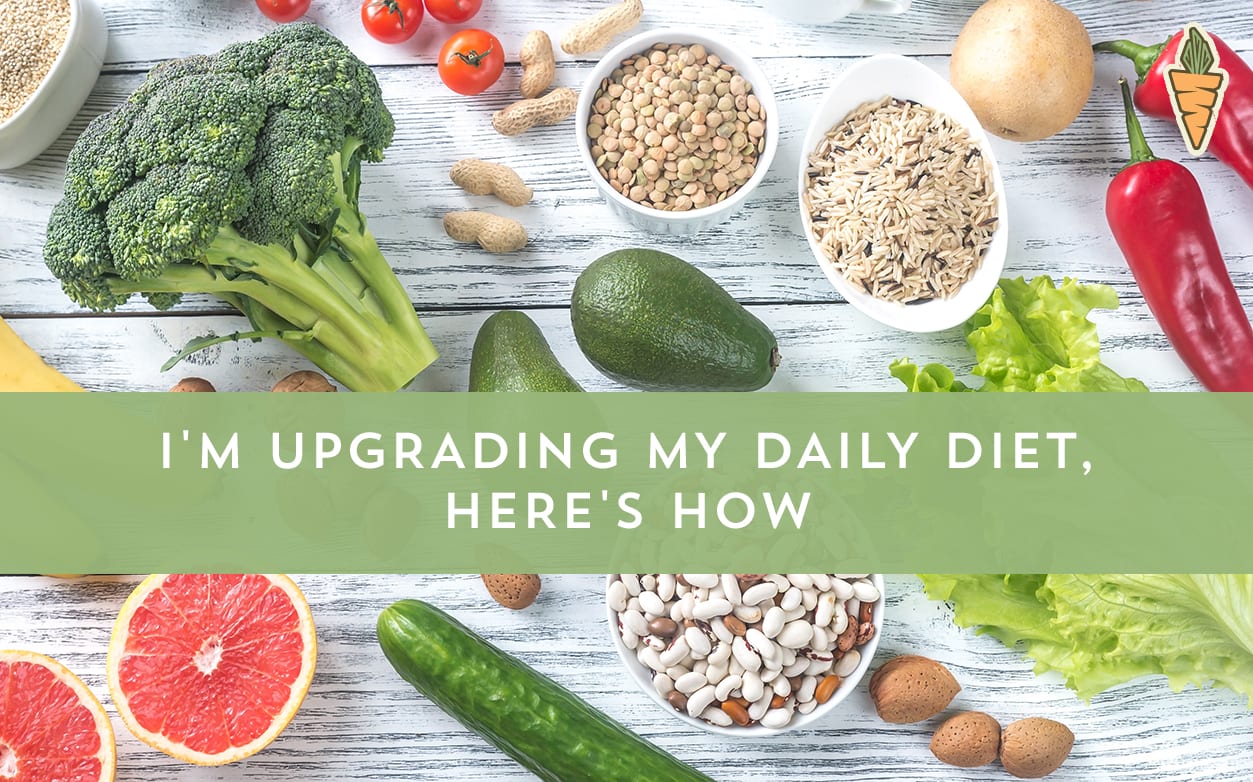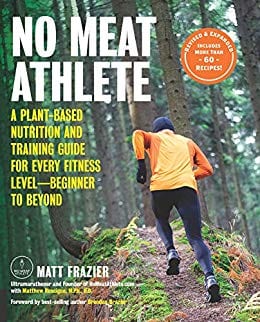
I’m Upgrading My Daily Diet, Here’s How
At the beginning of this year, I set the goal to get into the best shape of my life in 2019.
This meant a return to running. Building strength, muscle, and quickness through Muay Thai. And probably lifting some weights, too.
One thing it didn’t mean, I thought, was a change to my diet.
I was already eating 100% plant-based, and mostly whole foods, when I told Doug in a recent episode of No Meat Athlete Radio that I was grateful not to have to worry about my diet in order to achieve this goal.
Well, I was wrong.
Since then, in thinking next-level about what it’ll take for me to achieve my fitness goals and others this year (I set nine of them!), I’ve realized how important anything that affects my energy levels — and indeed, anything I do every single day — is.
Hence more closely examining my supplementation routine, my daily schedule, and of course, my diet.
Upgrading My Daily Meal Plan
After I joined a mixed martial arts gym and started Muay Thai last fall, I found myself (not surprisingly) hungrier than I had been before, and eager to make sure I was eating enough to recover from workouts and build muscle.
So I started eating everything. Still vegan, of course… but white flour, oil, salt — if it made food taste better and made me eat more of it, I was in.
Or rather, it was in. Me.
It worked, like I knew it would. I added a lot of muscle, quickly. But I was always bloated, and although, admittedly, the departure from healthy eating was fun, I knew I’d need to find a way to build muscle while still eating healthily for the long term.
I made two decisions:
1. Start cooking ahead of time, “for the freezer,” so that I’d always have a healthy, substantial meal at the ready.
The motivation here: I found myself eating junk around lunchtime after my workouts if I didn’t have leftovers from the previous night’s dinner. This is the time when I was most ravenous, and could rationalize anything as “good for post-workout refueling.” By always having a healthy meal available, I eliminated that issue.
(Previously I had been eating a big salad with beans for lunch, but I found this wasn’t enough calories once my workouts became intense.)
Cooking ahead of time — every few weekends, I knock out several double-batch recipes at once — has also freed up my wife and myself from cooking, for several nights a week.
Last year we did a good job of stocking quick meals we knew the kids would eat (frozen veggie burgers and falafel from Trader Joe’s, for example) to avoid the old “No way in hell we’re cooking tonight, let’s just order something.” But this year, instead of the greasy frozen food, it’s non-greasy frozen food I’ve made ahead of time.
Big win there. At the bottom of this post, I’ll share the two “for the freezer” recipes I happened to cook earlier this week.
2. Stop cooking with oil.
I stopped eating oil back in 2015, and lasted six solid months that way. I felt great and didn’t lose any weight like I had worried I would, but ultimately, I missed cooking with olive oil. So it slowly crept back into my diet (though I was much more careful with it than before).
But recently, motivated by a major heart scare my mom had, I decided that “it tastes good and I really like cooking with it” isn’t a good excuse.
It’s actually not the caloric density of oil that scares me — it’s what happens to oil when it’s heated (and worse, reheated), especially at the high temperatures we use for sautéing and frying. Oxidation, peroxidation, and the creation of mutagens that our bodies don’t recognize and that are linked to cancer.
I’m not really into that.
So I’ve once again cut the oil, with just a few exceptions.
My three allowances with oil:
1. I’m okay with drizzling unheated extra-virgin olive oil on salads, or other foods I might eat that traditionally involve a drizzle of oil at the table (pan con tomate is the only other example I can think of right now). This happens about twice a week, for me, and the amount is small (a teaspoon or so).
Like I said, it’s the heating of oil that most concerns me, so no major issue here.
Why the “extra-virgin” requirement? Because extra-virgin olive oil is the only oil I know of that, in some studies, has been shown not to cause arterial impairment in the hours following its consumption.
(There’s a lot of interesting and confusing research on this topic — some shows that red wine in combination with extra-virgin olive oil avoids arterial inflammation, while others suggest that even extra-virgin oil is harmful to the endothelial cells lining our arteries. Adding to the confusion, it’s not always clear whether the oil in the studies is heated in cooking or instead served raw.)
According to Dr. Greger, any protective effect of extra-virgin oil is because of the fact that “Extra-virgin olive oil retains a fraction of the anti-inflammatory phytonutrients found in the olive fruit, and so doesn’t appear to induce the spike in inflammatory markers caused by regular olive oil.”
So certainly not a whole food, but closer, perhaps, than other oils. And some of the evidence for how our arteries respond seems to support this.
2. I’m okay with simmering extra-virgin olive oil in tomato sauce over very low heat.
Partly because low heat is better than high (and olive oil is fairly stable due to low polyunsaturated fat content), partly because it’s a Blue Zones kind of thing to do, partly because I love cooking Italian food and consider it my mission to collect as many great sauce recipes as I can, and partly because of the way that extra virgin olive oil and tomatoes interact, when slow-simmered, to enhance the cancer-fighting properties of tomatoes. (I learned this from anti-angiogenesis pioneer Dr. William Li.)
3. If I’m out to eat, I don’t worry about it then.
You could argue these exceptions are excuses. So could I. They might be.
I’m okay with that.
My New Meal Plan
I used to eat like this:
- Smoothie for breakfast.
- Giant salad with beans and nut-based dressing for lunch.
- A grain, a green, and a bean for dinner
- Fruit for snacks
(You can get more details about this simple meal plan structure here. I like it because it makes it very easy for me to include my 7 Foods Worth Eating Every Single Day.)
But now, given that find myself wanting to eat an entire pizza at 11am after my workouts, I eat like this:
- Smoothie for breakfast*
- Beans and grains for lunch (leftovers, or from my freezer collection)
- A medium-sized salad and a grain, a green, and a bean for dinner
- Fruits, hummus and veggies, and cereal with almond milk for snacks
*I’ve added tart cherry juice to my smoothie recently, mainly for workout recovery. The other ingredients, most days, are flaxseeds, walnuts, bananas, and mixed frozen berries.
Oh, and I have a single cup of light-roast coffee each morning, and most nights a glass of wine or beer after dinner.
So there you have it. My 2019 meal plan. Until it’s time to change it.
‘For the Freezer’ Recipes
For some examples, or loads of fun playing along at home, here are two of the freezer meals I’ve cooked this week, both from my book No Meat Athlete, Revised & Expanded, Fair Winds Press, October 2018.

Note: I cook these recipes without the oil now, and when I’m cooking for the freezer, leave out anything that would work better as a last-minute garnish. This includes the last-minute garnishes (duh), greens wilted in a stew or soup, and sometimes seasonings, like the toasted spice blend in the curried red lentils recipe. Streamline, baby.
No nutrition info included here. I don’t pay attention to that stuff at all. It’s in the book though, because people leave bad reviews if you don’t put it in cookbooks. I tried it once.
Enjoy!
Simple Spanish-Style Stewed Beans in Tomato Sauce
1 can (14.5 ounces) fire roasted diced tomatoes (or whole peeled tomatoes and their juice, pureed)
2 large cloves garlic, minced
1 can (19 ounces) white beans, such as cannellini, drained
Salt and black pepper, to taste
Vegan Parmesan Sprinkle, for serving (recipe in book, but you can use this one instead)
Extra virgin olive oil (optional), for serving
4 slices rustic whole-grain or sourdough bread (optional), for serving
Add the entire contents of the tomato can and garlic to a medium skillet and bring to a simmer over medium heat.
After 5 minutes of simmering, add the white beans. Lower the heat to medium-low and cook, stirring occasionally to prevent the beans from sticking, for an additional 12 to 15 minutes, until the tomatoes begin to break down and most of the liquid has evaporated.
If the pan gets dry too quickly, add a splash or water or two to allow the simmering to continue.
Add salt and black pepper to taste.
Serve topped with a few tablespoons of Vegan Parmesan Sprinkle and, optionally, a drizzle of extra-virgin olive oil, alongside toasted rustic bread.
Super Quick Red Lentils and Rice
2.5 cups red lentils, rinsed under cold water until it runs clear
6 cups water
1 teaspoon ground turmeric
1.5 teaspoons chili powder
1.5 teaspoons salt
2 tablespoons coconut or grapeseed oil [Note: I omit this now]
1 teaspoon fennel seed
1.5 teaspoons cumin seed
1.5 teaspoons dried marjoram or oregano
.25 teaspoon crushed red pepper flakes, more to taste
4 cups baby spinach
.5 cup fresh cilantro, chopped
Lemon juice, for serving
Hot sauce, for serving (optional)
6 to 8 cups cooked brown rice, for serving
Combine the lentil and water in a large pot and stir in the turmeric, chili powder, and salt.
Bring to a boil over high heat and then reduce heat to medium and simmer, uncovered, stirring occasionally until the lentils are tender and the mixture is more or less homogeneous, 25 to 30 minutes. (Some of the lentils will dissolve completely while others will just barely hold their shape and provide some texture.)
When the lentils are about 2 minutes from being done, heat the oil in a separate pan over medium-high heat. [Again: I don’t do that part anymore, and instead just lightly toast the spices in a dry skillet.]
Add the fennel and cumin seed, marjoram, mustard seed, and red pepper flakes and stir for a minute. Then pour the spice-and-oil mixture into the pot with the lentils, along with the baby spinach, and stir to combine and wilt the spinach.
Serve over brown rice, garnished with cilantro, lemon juice, hot sauce, and more salt to taste.
When reheating this dish (or if it sits for a while on the stove and begins to dry out), simply add some hot water and it will be like new again!




Leave a Reply